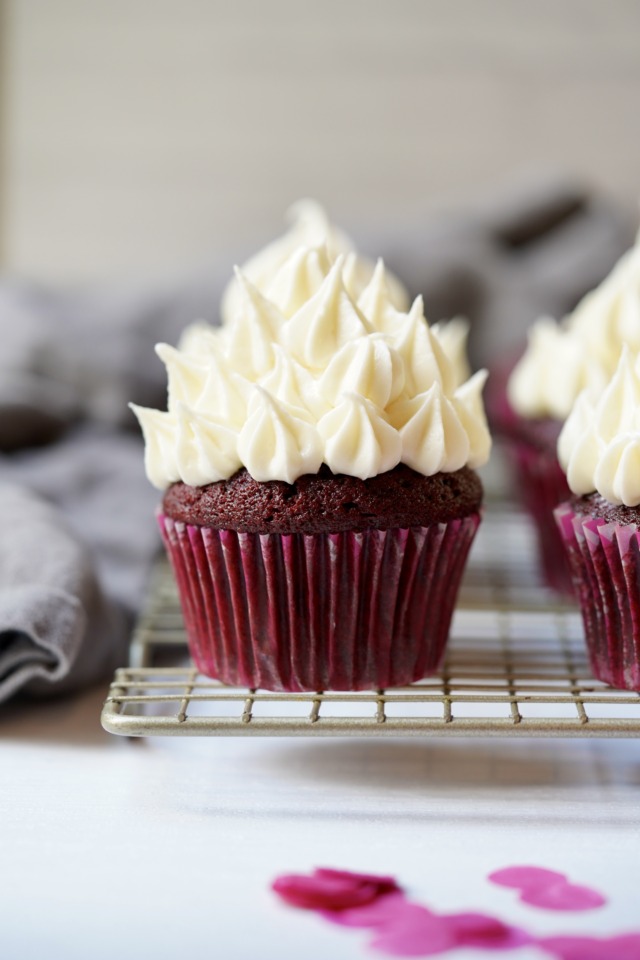
Red Velvet Cupcakes
Red velvet cupcakes (or cakes) are traditionally red, crimson, or scarlet-colored colored cakes, with fluffy white ermine icing. And aside from my classic coconut layer cake, red velvet has become a recent obsession of my older son. The deep red hue of this popular flavor is visually striking and immediately draws attention. For my kid, it was love at first bite.
What Makes Red Velvet So Special?
The uniqueness of red velvet is not just because of its color, but rather its texture and slightly tangy flavor. Both moist and dense, with a fine crumb, is what makes red velvet so incredibly satisfying. The addition of cocoa powder to the batter is what adds a rich, subtle chocolatey flavor that is so memorable.
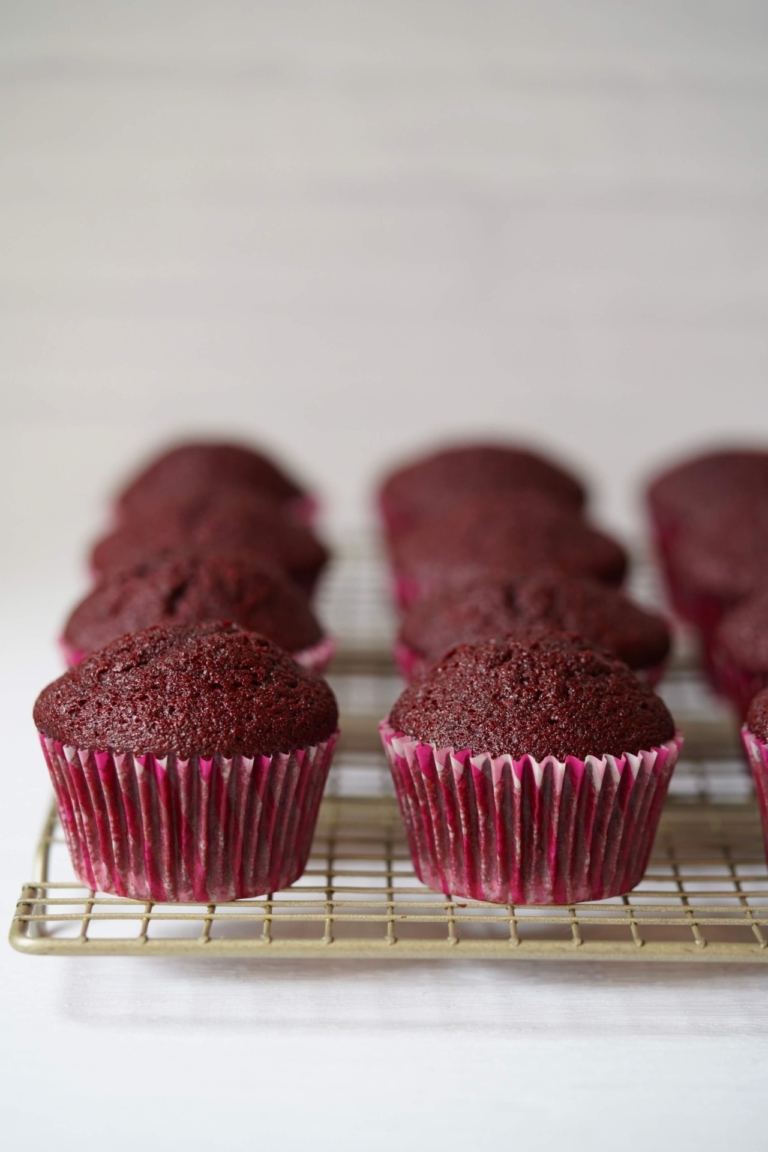
Red Velvet in History
In the 19th century, “velvet” cake, was a soft and velvety crumb cake served as a fancy dessert. This was in contrast to what had been the more common, coarser-crumbed cake. Around the turn of the 20th century, devil’s food cake was introduced, which many say is what led to red velvet’s invention. The key difference between the two cakes is that Devil’s Food Cake uses chocolate and red velvet cake uses cocoa.

Chemical Reaction
Before the use of food coloring, the vibrant red velvet color was achieved by a chemical reaction between acidic ingredients (buttermilk) and cocoa powder. The reaction caused the anthocyanin pigments present in the cocoa to develop a reddish hue, giving the cake a distinctive color. However, this reaction alone will not produce the vibrant red color typically associated with red velvet desserts today.
To further enhance the color, some recipes add vinegar or lemon juice to the batter. The additional acid intensifies the reaction between the cocoa powder and buttermilk, resulting in a brighter, more vibrant red color.
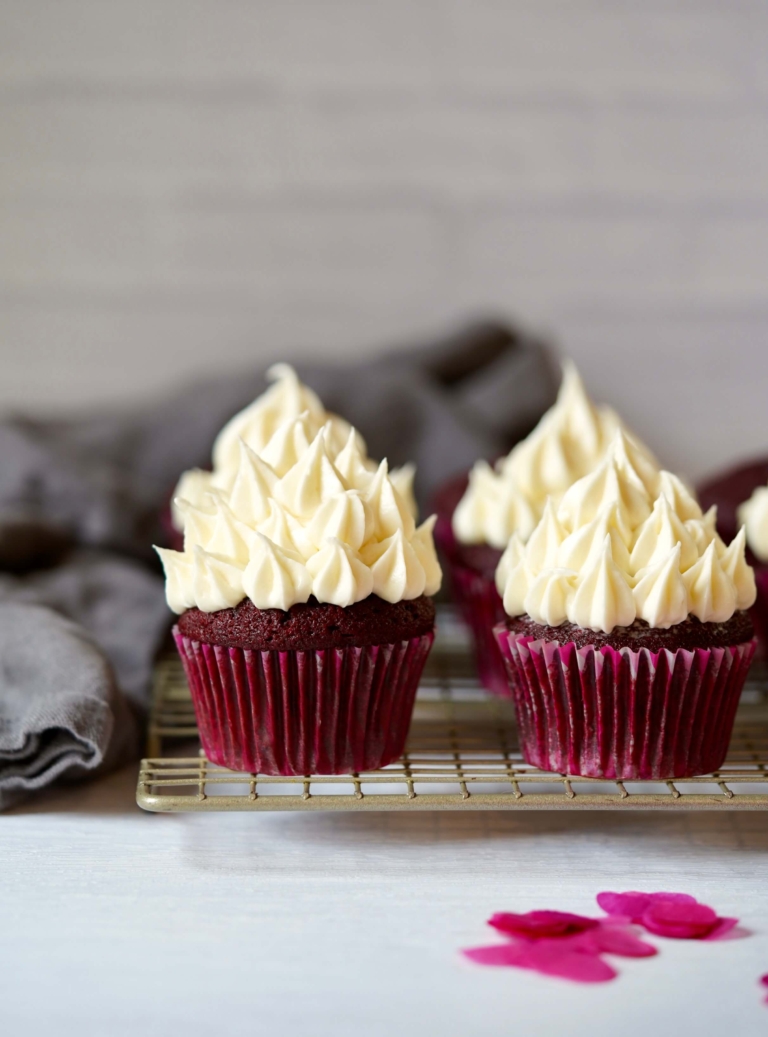
Natural Coloring Agents
When foods were rationed in the US during World War II, bakers used natural ingredients such as boiled beet juices to enhance the color of their cakes. Beets were, and often still are, used to help retain moisture. Adams Extract (and Sterling Crim an executive from the South) are credited with popularizing red velvet cakes during the Great Depression era because they were the first to sell red food coloring.
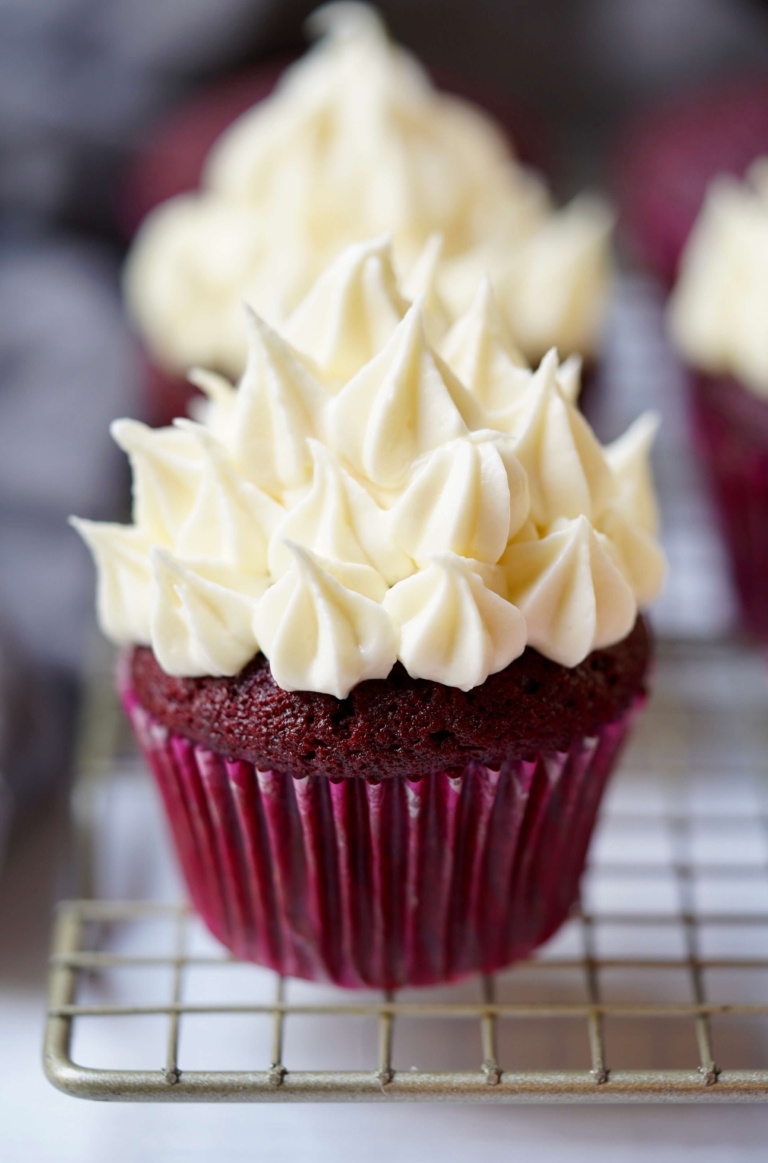
Southern Favorite
In the 1930s, the Waldorf-Astoria, a well-known hotel in NYC, was one of the first to begin serving red velvet cake and thus credited for its invention. But in actuality, they likely only capitalized on a cake already popular throughout the country at the time. The cake itself is not very old, and truthfully, not all that Southern, except for the addition of buttermilk. But invention aside, red velvet is a big flavor favorite in the South and considered a go-to at Christmas and Juneteenth celebrations.
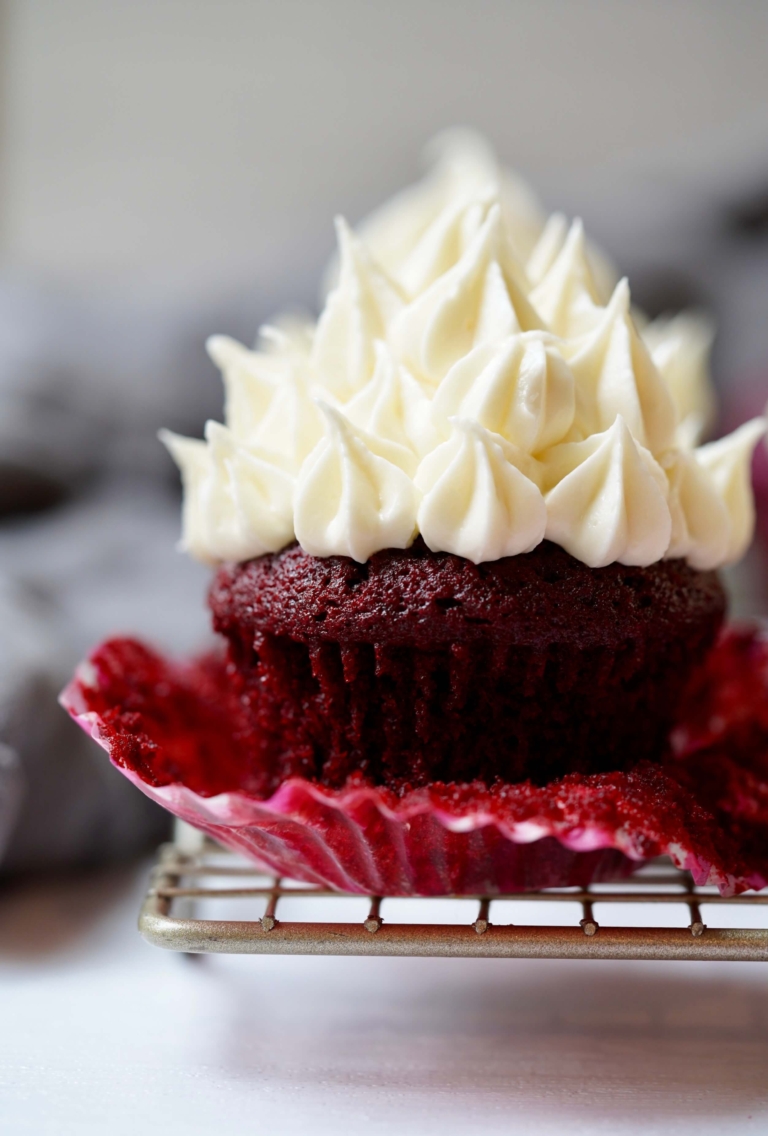
In Honor of Eli
Cream cheese frosting on modern red velvet cupcakes (and cakes) is also a factor in the flavors’ popularity. The tangy, yet sweet frosting pairs perfectly with the slightly chocolatey flavor of the cake. The rich, indulgent topping adds yet another layer of visual interest. I developed this recipe for my son in honor of his 18th birthday today (May 4th). Just a few weeks from now we have his high school graduation. These are some happy, emotional, bitter-sweet, celebratory times. Happy birthday, happy graduation, happy everything E!
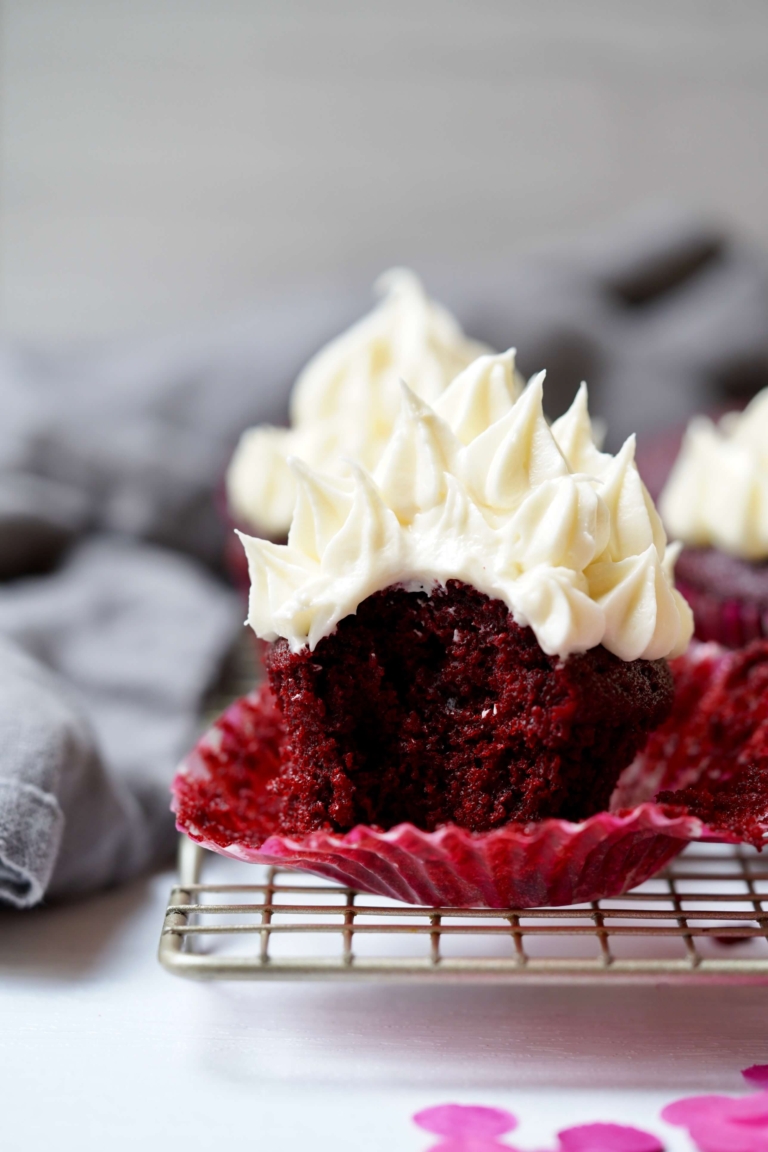
Red Velvet Cupcakes
Ingredients:
For the Cupcakes:
- 1/2 cup boiling water
- 1/4 cup good quality, unsweetened cocoa powder
- 2 1/4 cups all-purpose flour
- 1 teaspoon baking soda
- 1/2 teaspoon baking powder
- 1/4 teaspoon salt
- 1/4 teaspoon cinnamon
- 2 cups sugar
- 1/2 cup vegetable oil
- 1/2 cup unsalted butter, melted
- 2 eggs, room temperature
- 1 egg yolk, room temperature
- 1 cup buttermilk
- 1 tablespoon vanilla extract
- 1 1/2 tablespoons red food coloring (or less if desired)
- 1 teaspoon distilled white vinegar
For the Cream Cheese Frosting:
- 16 ounces cream cheese, room temperature
- 1 cup unsalted butter, room temperature
- 2 teaspoons vanilla extract
- 4 cups Confectioners' sugar, sifted
Directions:
- Preheat the oven to 325 degrees F. Line 18 cupcake molds and lightly oil. Set aside.
- For the cupcakes: In a small bowl whisk the hot water and cocoa powder together till blended. Cover and let stand for about 5 minutes.
- In a medium mixing bowl add the flour, baking soda, baking powder, salt, and cinnamon and blend. Set it near your workstation.
- In the bowl of a kitchen mixer, such as a KitchenAid, fitted with a paddle attachment, add the sugar, vegetable oil, and melted butter and beat on low. Add in the eggs and yolk and mix until incorporated. With the mixer running, slowly add in the buttermilk, vanilla, and red food coloring. Next, add the vinegar and hot water-cocoa mixture. Slowly add the flour mixture and mix to blend, scraping down the sides with a rubber spatula as needed.
- Divide the batter equally between the prepared cupcake molds. Tap the pan gently against the counter to release any air bubbles. Place in the oven and bake for about 25 or until a cake tester comes out clean. Allow the cupcakes to cool completely before frosting.
- For the frosting: In the bowl of a kitchen mixer, fitted with the paddle attachment, add the cream cheese and butter and beat on medium-high speed until light, creamy, and very smooth. Add in the vanilla and beat until combined. With the mixer on low, slowly add in the sugar and beat until fluffy, about 3 minutes. Frost the cupcakes with an offset spatula or use a piping bag and pastry trip to make a more decorative frosted cupcake. Store cupcakes in the refrigerator for up to three days.


